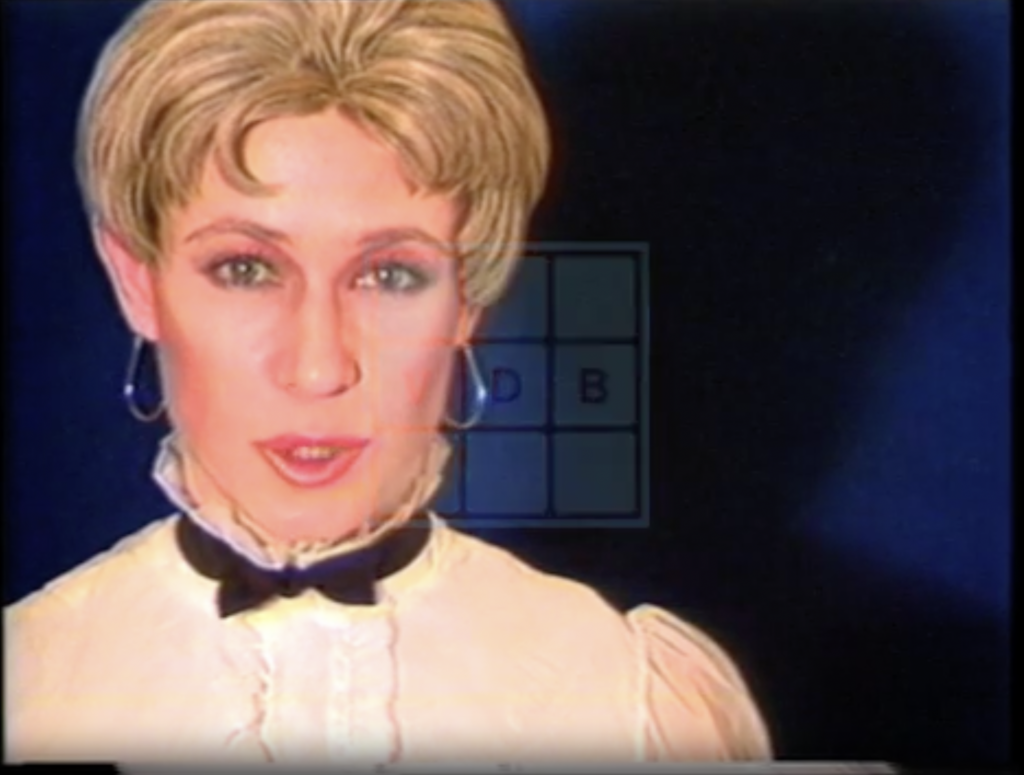This evening of film screenings and lectures echoing the practice of Nicole Eisenman, whose work was on show at the Fondation Vincent van Gogh Arles in the exhibition “Nicole Eisenman and the Moderns. Heads, Kisses, Battles” curated by Bice Curiger.
This evening was conceived with assistant curator Margaux Bonopera
Fondation Vincent van Gogh Arles
June 2022
“About Feelings, Laughter and Streets” draws on experimental films produced in the New York of the 1980s and 1990s – films issuing from the same artistic milieu as Eisenman and pursuing similar formal experiments and questions. This screening event is an opportunity to honour the short films made by the Ridykeulous collective founded in 2005 by Eisenman and A.L. Steiner, as well as the TV productions by the American journalist and artist Glenn Belverio, such as The Lesbian Museum (1992).
Through eight films dating from 1984 to 2020, “About Feelings, Laughter and Streets” is a chance to immerse ourselves visually in Eisenman’s artistic biotope, and at the same time to discern the enduring resonances of these experimental New York productions in the practice of younger artists, notably in the sphere of animation.
PROGRAMME :
Ridykeulous (Nicole Eisenman + A.L. Steiner), Times Square S.C.U.M. MANifesto (2011), 7 min
Ridykeulous is a curatorial initiative headed by artists Nicole Eisenman (b. 1965, Verdun) and A.L. Steiner (b. 1967, Miami) and founded in 2005. Ridykeulous mounts exhibitions and events primarily concerned with feminist and queer issues, and uses humorous strategies to critique the art world and culture at large.
Hannah Quinlan & Rosie Hastings, Everything Is Folly In This World That Does Not Give Us Pleasure (2021), 2 min 26
Hannah Quinlan (b. 1991) & Rosie Hastings (b. 1991) are a duo based in London. Working across drawing, film, installation, performance and fresco, their practice examines the behaviours, history, politics, and artefacts of LGBTQIA+ culture in the Western context. Quinlan and Hastings are committed to exposing nationalism, masculinity, and whiteness within the LGBTQIA+ community and the effects on the community of state-led violence, including policing, gentrification, and austerity.
Glenn Belverio, The Lesbian Museum, 1992, 29 min
Glenn Belverio (b. 1975, New York) is an independent filmmaker living and working in New York City. In 1990 he began producing and co-hosting the popular US cable-TV series The Brenda and Glennda Show, of which The Lesbian Museum forms one episode. The show was designed to popularize the art of drag queens, while addressing the issues of gender and gay politics being debated in American society at that time. At the Lesbian Museum, Brenda and Glennda interview artists at the opening of Christine Martin’s controversial exhibition The Lesbian Museum: 10,000 Years of Penis Envy at Franklin Furnace. For the exhibition, each artist (including Brenda and Glennda) were given a dildo and asked to turn it into a work of art.
Dana DeGiulio, Dr Zoom – Episode 1-8, 2020, 8 min 41 s
Dana DeGiulio (b. 1978, Chicago) is a painter whose project pits action and materiality against image. Her work in video, drawing, installation, painting, writing and teaching is about edges and touch and attention. An itinerant professor of visual art for the last fourteen years, Dana DeGiulio currently teaches at New York University, Columbia University, and the School of the Art Institute of Chicago. She works at home in Brooklyn next to the window.
Hannah Quinlan & Rosie Hastings, Gaby, 2018, 7 min 55
The first part of Gaby includes a montage of found video clips in which active police dance at pride parades to Y.M.C.A. , The Village People’s iconic 1978 song. Over the last decade, similar sequences have been making the headlines of news outlets, triggering an unanimous positive reaction. Often joined by celebrating paraders, the officers are usually caught on mobile phone cameras, and their apparent amicability clashes strongly with today’s alarming rise of police brutality. The film follows with an animatic sequence of a 1977 issue of the gay magazine Christopher Street, extolling, mostly white, male gay communities’ propensity to rejuvenate disregarded neighbourhoods and “save” Manhattan from the “slums”, in what can be understood as early testimonies of a queer history of gentrification in New York.
Sadie Benning, If Every Girl Had a Diary, 1990, 8 min
Sadie Benning (b. 1973, Madison) is a self-taught American filmmaker and artist. Known for their intimate films addressing issues of homosexuality, identity and desire, they enjoyed some success on the 1990s American art scene. They remain one of the most famous representatives of the New York underground culture of that epoch.
Tom Rubnitz and Ann Magnuson,Made for TV, 1984, 15 min
Thomas Rubnitz (1956, Chicago – 1992, New York) is an artist particularly known for the videos he made during the years 1980– 1990. Originally from Chicago, he spent most of his life in New York’s East Village, a centre of American gay and queer culture. This emblematic figure of the 1980s New York underground scene leaves behind an essential, political, joyful and insolent body of work. Tom Rubnitz died of an AIDS-related illness in 1992.
Anna Mantzaris, ENOUGH, 2017, 2 min 22 s
Swedish animation director and filmmaker Anna Mantzaris (b.1986, Stockholm) holds an MA in Animation from the Royal College of Art in London. Her films have won over 80 international awards, including the European Animation Award, the Vimeo Award for Best of the Year, the Walt Disney Award and the Audience Award at the Ottawa International Animation Festival. She teaches on an occasional basis and has been a guest lecturer at the Royal College of Art in London, the Stockholm University of the Arts and the National Film & Television School in England.

